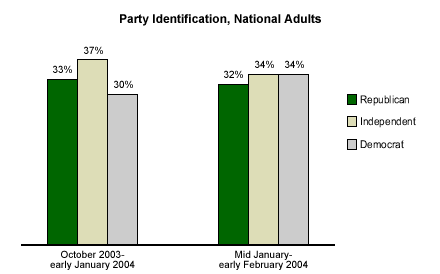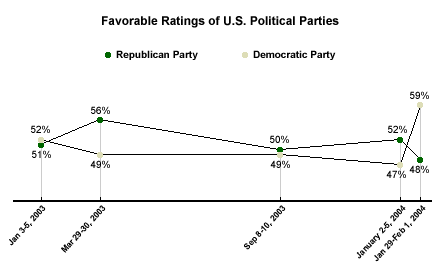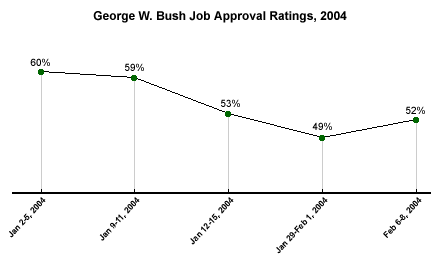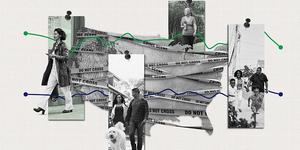Recent Gallup Polls picked up a significant swing among Americans toward the Democratic Party during the most intense period of the Democratic nomination campaign. This is evident in a number of ways, including Americans’ current party identification, lower presidential job approval ratings for President George W. Bush, and more positive ratings of the Democratic Party.
The shift most likely resulted from intense news coverage of the Democratic presidential nomination campaign, and was probably helped by the surprising results in the Iowa caucuses, in which Sens. John Kerry (Mass.) and John Edwards (N.C.) vaulted to the front of the field with surprise showings after trailing in most national polls. The recent Iowa caucuses and the New Hampshire primary both set records for voter participation, and, nationally, interest in the election is unusually high for this stage of an election year. So, with Americans highly attentive to politics, and media coverage focused on the Democratic Party, the political environment currently favors the Democrats. However, the latest Gallup Poll does suggest that the Democratic tide may be receding, as Kerry’s success in the Democratic primaries and caucuses has caused the initial excitement of the campaign to die down, and more media attention is being focused on the president.
Evidence of a Democratic Shift
In two Gallup Polls conducted from mid-January to early February, the percentage of Americans identifying themselves as Democrats increased by about four percentage points over the percentage in the latter part of 2003 and first two weeks of 2004, from 30% to 34%. Meanwhile, the percentage identifying themselves as Republicans has dropped about one point. That has resulted in a net shift of five points toward the Democratic Party, from a two-point Republican edge to a three-point Democratic edge.

Shifts in partisanship in the aggregate are not uncommon, and while they are apparent, they typically are not large. For most Americans, partisanship is not something that changes very easily. But a significant proportion of Americans hold rather weak ties to the parties, and their self-identification as a Democrat, Republican, or independent can be and is influenced by the prevailing political environment.
The current shift also bucks the larger trend of increased Republican identification that has been evident for the past two decades. In fact, in the last two years, Republicans have held an edge over Democrats -- for the first time in Gallup’s polling history.
Beyond partisanship, the changing political environment is also apparent in other attitudinal measures. For example, the public’s favorable ratings of the two political parties have changed greatly since the nomination campaign began in earnest. At the beginning of this year, 47% of Americans had a favorable view of the Democratic Party, which is about where it was for most of last year. The latest measurement, from a Jan. 29-Feb. 1 poll, shows that 59% of Americans now hold a positive view of the Democratic Party. Meanwhile, ratings of the Republican Party have shown a slight dip, from a 52% favorable rating in the first poll of this year to 48% in a recent poll.

In this period, Bush’s job approval rating has also tumbled. Bush began the year with a 60% job approval rating, still reflecting the glow of the capture of Saddam Hussein in mid-December. But by mid-January, Bush’s approval rating dropped to 53%, and dropped further to a term low of 49%. In the latest poll, however, Bush’s job approval rating has recovered somewhat to 52%, but it still is significantly lower than where it was at the beginning of the year.

The Democratic candidates have spent a great deal of their campaigns criticizing Bush, maybe even more so than criticizing each other. Bush’s attempts to reinsert himself in the debate -- by scheduling the State of the Union speech for the night after the Iowa caucuses, and campaigning in New Hampshire a couple of days after the primary -- have not been especially successful in distracting media attention from the Democrats. Additionally, most of the recent coverage of Bush has tended to be negative -- including reports about intelligence failures regarding Iraq’s weapons of mass destruction, significant underestimates of the cost of the new Medicare prescription drug plan, and criticism over record budget deficits.
However, the new Gallup Poll, conducted Feb. 6-8, shows a slight recovery in Bush’s job approval rating, and the Democratic movement in party identification subsiding.
Historical Context
While the change in the political environment is dramatic, it is not unprecedented. It is common for public attitudes to shift during intensely political times, especially when one party is dominating the news and generally getting favorable media coverage. This is most commonly associated with the major parties’ political conventions each election year, and is probably the dynamic underlying presidential candidates’ convention bounces.
Similar shifts in public attitudes have also occurred during times of war and in the aftermath of elections. For example, a greater percentage of Americans identified themselves as Republicans during the Persian Gulf War in 1991 than immediately before it, and following the Republican capture of Congress in 1994 than before it. Likewise, the percentage of Americans identifying themselves as Democrats spiked during President Bill Clinton’s impeachment proceedings in late 1998, when the public generally disapproved of the congressional Republicans pressing the issue.
There is also some historical evidence that suggests party presidential nomination campaigns may produce a shift in party sentiment. In the latter part of 1995 and first few weeks of 1996, Democrats had a roughly two-point edge in party identification over Republicans. But beginning in February and March, when the Republican presidential nomination was being decided, the two parties were equal or the Republicans had a numerical advantage. By April, Democrats had regained their previous advantage.
It is not clear if similar shifts occurred during other presidential nomination campaigns, because Gallup did not poll as frequently during nomination campaigns in the past as it does now. But prior to 1996, the primaries were not as front-loaded as today, so the news coverage of the nomination was less intense as the campaign typically lasted three months or longer. In 1996 and 2000, the party’s presidential nominees were generally decided about a month after the primaries and caucuses began.
What the historical data suggest, both for the 1996 campaign and other rallying events, is that the effects are generally short-lived. As the events become more distant and news coverage returns to a more normal balance, party identification generally settles back to where it was just prior to the event. Indeed, the new Gallup Poll suggests that the political environment could be returning to its previous state. Future polls will confirm whether this is in fact the case.
